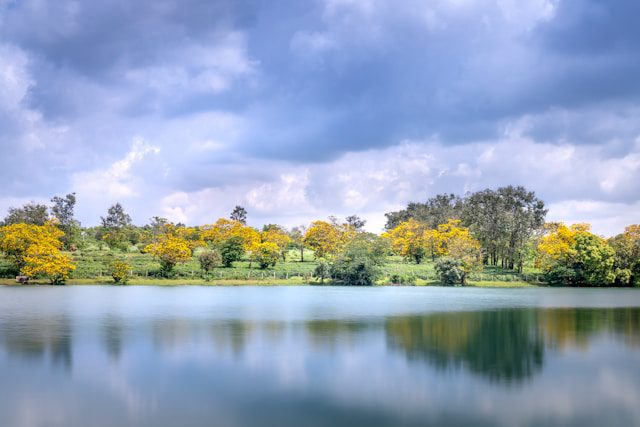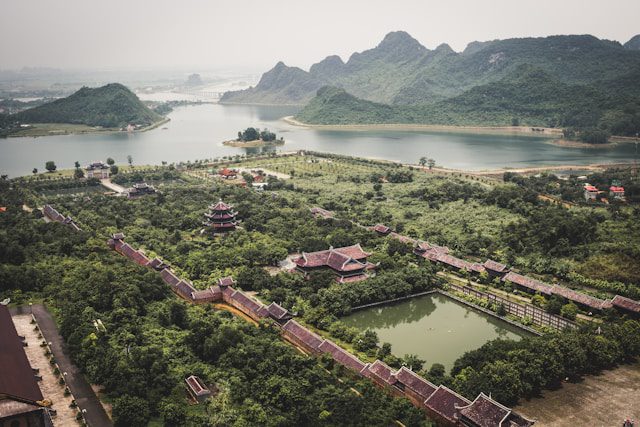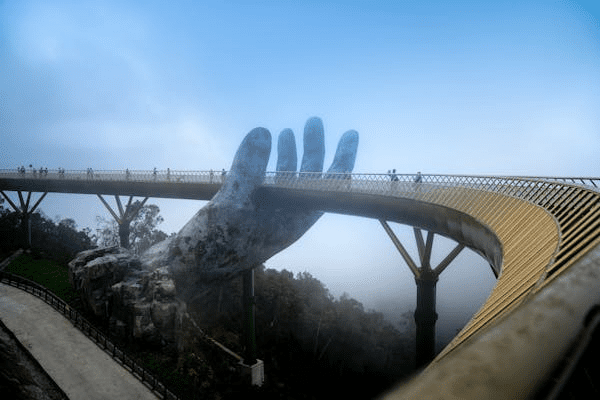Spring in Vietnam, spanning from February to April, brings a magical transformation across the country. From the cool mountains of the north to the tropical beaches of the south, each region offers its own unique springtime charm, creating perfect conditions for exploring this diverse nation.
Whether you’re planning to witness traditional Tet celebrations, explore ancient temples, or experience the emerging warmth before the summer heat arrives, this comprehensive guide will help you plan your springtime journey through Vietnam.
Weather in Vietnam in Spring
Spring weather in Vietnam varies significantly between the northern, central, and southern regions, making it essential to plan your activities based on local conditions.
|
Whether Elements |
Details |
|
Temperature |
Hanoi, Ha Long Bay:
Da Nang, Hoi An:
|
|
Humidity |
Hanoi, Ha Long Bay:
Da Nang, Hoi An:
|
|
Precipitation |
Hanoi, Ha Long Bay:
Da Nang, Hoi An:
|
|
Average Sunset Time |
Hanoi, Ha Long Bay:
Da Nang, Hoi An:
|
Why Visit Vietnam in Spring?
Spring emerges as one of the most rewarding times to explore Vietnam, offering unique cultural experiences and optimal conditions for various activities before the intense summer heat and rains arrive.

Perfect Weather Window
Spring presents an ideal climate balance Vietnam’s diverse regions. The north sheds its winter chill, with Hanoi enjoying pleasant temperatures between 18-23°C in March, perfect for exploring the Old Quarter or taking day trips to Ha Long Bay. The central region maintains comfortable conditions around 24-30°C, ideal for beach activities and cultural exploration in Hoi An and Hue.

Significant Cost Savings
Spring offers exceptional value with prices significantly lower than peak winter season:
- 5-star hotels: 20-30% reduction in rates
- 4-star hotels: 15-25% lower prices
- International flights: 15-25% cheaper from major Asian cities
- Many properties include complimentary upgrades, breakfast, or airport transfers
Cultural Festival Season
Spring hosts Vietnam’s most significant cultural celebrations, starting with Tet (Lunar New Year) festivities. The Lim Festival in February showcases traditional folk songs, while the Perfume Pagoda Festival (February-March) offers spiritual insights. The Hung Kings Temple Festival in April provides a deep connection to Vietnam’s founding legends.

Optimal Exploration Conditions
With tourist numbers 30-40% lower than peak season, spring offers a more relaxed experience at major attractions. The Temple of Literature in Hanoi and Cu Chi Tunnels near Ho Chi Minh City see 30-50% shorter queuing times. This reduced crowding allows for more intimate experiences at historical sites and better photography opportunities.
Unique Natural Experiences
Spring presents ideal conditions for exploring natural wonders like the Hang Son Doong cave in Quang Binh province. As the world’s largest cave system, it offers surreal landscapes of underground rivers and forests, best experienced before summer rains arrive. The comfortable temperatures and clearer skies make spring perfect for such adventures.
Emerging Food Scene
Spring marks the beginning of Vietnam’s fresh produce season, with markets brimming with seasonal delicacies. Local restaurants update their menus to feature spring specialties like fresh herbs, young rice dishes, and seasonal seafood. Many establishments offer cooking classes during this period, teaching traditional spring recipes and techniques.
Eco-Cultural Participation
A unique spring experience is participating in the Tet tree planting ceremony, typically held in February or early March. This eco-friendly cultural practice welcomes tourists to join local communities in planting trees, believed to bring good fortune for the new year. It offers an authentic way to connect with Vietnamese traditions while contributing to environmental conservation.
Top Things to Do in Spring
Spring in Vietnam offers perfect conditions for both outdoor adventures and cultural experiences. Here’s how to make the most of this vibrant season.
Explore Historical Sites
The comfortable spring temperatures create ideal conditions for exploring Vietnam’s rich historical heritage. Visit the Temple of Literature in Hanoi during early morning hours (8:00-10:00 AM) when crowds are thinner and temperatures milder.
The Cu Chi Tunnels near Ho Chi Minh City are best explored during midday when natural lighting in the tunnels is optimal. Most historical sites maintain regular hours from 8:00 AM to 5:00 PM, with entry fees ranging from 30,000 to 150,000 VND ($1.30 to $6.50 USD).

Beach and Water Activities
Coastal areas come alive during spring, particularly in central Vietnam. An Bang Beach in Hoi An and My Khe Beach in Da Nang offer excellent facilities with plenty of shade from palm trees and beach umbrellas. Water parks like Vinpearl in Nha Trang maintain comfortable water temperatures between 28-30°C year-round, with enhanced safety measures including increased lifeguard presence and sun protection stations.
City Exploration
The best times for outdoor city exploration are between 7:00 AM and 10:00 AM, and again from 4:00 PM to 6:00 PM, avoiding the midday heat. Major cities like Hanoi and Ho Chi Minh City operate air-conditioned buses more frequently during spring. Many shopping malls organize special spring events including:
- Fashion shows featuring local designers
- Pop-up markets showcasing artisanal crafts
- Weekend entertainment programs for families

Cultural Immersion
Spring offers unique opportunities to experience Vietnamese culture:
Traditional Festivals
- The Lim Festival celebrates ancient folk songs
- Perfume Pagoda Festival combines spiritual pilgrimage with natural beauty
- Hung Kings Temple Festival honors Vietnam’s legendary founders
Local Experiences
Many communities welcome visitors to participate in traditional spring activities, including:
- Tea harvesting in highland regions
- Traditional craft workshops
- Local cooking classes featuring seasonal ingredients
Spring Festivals & Events
Spring in Vietnam is a vibrant season of celebration, blending deep-rooted traditions with lively modern entertainment. From cultural spectacles to shopping extravaganzas, the country comes alive with energy and charm.
Tet Holiday Celebrations (Vietnamese Lunar New Year)
Tet, Vietnam’s most important holiday, marks the arrival of spring and is celebrated with great fervor. Although the exact dates vary annually according to the lunar calendar (usually in late January or February), it remains a cornerstone of Vietnamese culture.
- Traditional Music and Dance: Performances such as lion dances, drum shows, and folk singing echo through neighborhoods.
- Holiday Markets: Vibrant bazaars sell Tet delicacies like banh chung (sticky rice cake), candied fruits, and festive flowers such as peach blossoms and kumquat trees.
- Family Reunions and Offerings: Families gather to honor ancestors, share meals, and exchange red envelopes (li xi) for good luck.
- Firework Displays: Cities like Hanoi, Ho Chi Minh City, and Da Nang host dazzling firework shows on New Year’s Eve.
Cultural Festivals
Vietnam’s spring season is rich in cultural festivals that showcase its traditions, artistry, and gastronomy.
Hue Festival (April):
Held in the historic city of Hue, this festival celebrates the legacy of the Nguyen Dynasty.
- Royal Court Performances: A display of music, dance, and rituals once performed in the imperial court.
- Art Exhibitions and Street Performances: Artists display calligraphy, painting, and traditional crafts, while the streets come alive with parades and folk art.
- Culinary Delights: Food stalls offer Hue’s unique specialties, including bun bo Hue (spicy beef noodle soup) and banh beo (steamed rice cakes).
Perfume Pagoda Festival (Mid-February to April):
One of Vietnam’s largest Buddhist festivals, it takes place at the Perfume Pagoda near Hanoi.
- Pilgrimage Rituals: Visitors climb to sacred temples to pray for health, prosperity, and happiness.
- Boat Rides: Picturesque boat journeys along the Yen Stream add to the spiritual experience.
- Vietnam’s spring season also caters to shopping enthusiasts with exciting fairs and deals:
Vietnam Spring Shopping Festival (Late February to April):
- Promotional Events: Retailers offer discounts on fashion, electronics, and local crafts.
- Cultural Activities: Workshops, fashion shows, and cooking demonstrations add a festive touch to the shopping experience.
These spring festivals often inspire visitors to extend their stay, Indian tourists can easily request a Vietnam visa extension to continue exploring the vibrant shopping scene and cultural celebrations.
What to Wear in Spring?
Vietnamese spring weather requires thoughtful packing, with clothing suitable for various activities and cultural settings.
|
Occasion |
Men |
Women |
|
Daytime Attire |
|
|
|
Cultural Sites |
|
|
|
Beach/Water Activities |
|
|
|
Evening/Dining |
|
|
Why Choose OneVasco?
OneVasco makes visa applications effortless. Our expert team manages the entire process, allowing you to focus on your journey.
Enjoy stress-free travel with fast visa approvals.
- Expert and Personalized Support
- Efficient and Hassle-Free Process
- Real-Time Tracking and Updates
- Transparent Communication
- Trusted by Millions
FAQs
Is spring suitable for children to visit Vietnam?
Yes, spring is ideal for family trips with moderate temperatures and numerous child-friendly festivals. Water parks and indoor attractions also offer special spring activities for kids.
Can you swim on Vietnamese beaches during spring?
Yes, especially in central and southern regions where water temperatures are comfortable (24-28°C). Morning hours offer the best swimming conditions.
Are spring allergies common in Vietnam?
While less common than in temperate countries, tree pollen levels can be high in February and March, particularly in Hanoi and highland areas.
How early should I book spring festival accommodations?
Book at least 2-3 months ahead for accommodations during major festivals like Tet and the Hue Festival, as hotels can fill up despite being an off-peak season.
Are there any unique spring souvenirs to buy?
Yes, look for seasonal items like spring tea harvests, traditional festival crafts, and special Tet decorations which are only available during this season.





















